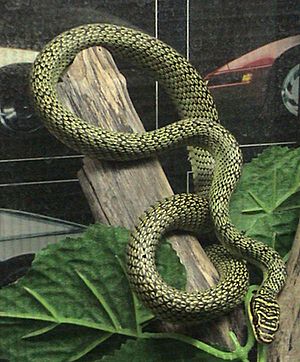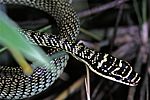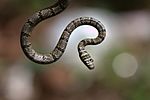Chrysopelea facts for kids
Quick facts for kids Chrysopelea |
|
|---|---|
 |
|
| Ornate flying snake, Chrysopelia ornata | |
| Scientific classification |
|
| Kingdom: | Animalia |
| Phylum: | Chordata |
| Class: | Reptilia |
| Order: | Squamata |
| Suborder: | Serpentes |
| Family: | Colubridae |
| Subfamily: | Ahaetuliinae |
| Genus: | Chrysopelea Boie, 1826 |
| Type species | |
| Chrysopelea ornata |
|
| Species | |
|
|
Chrysopelea, often called flying snakes or gliding snakes, are a special type of snake. They belong to a family of snakes called Colubridae. Even though they are called "flying" snakes, they actually glide through the air. These snakes have a mild venom. However, this venom is only harmful to the small animals they hunt. You can find flying snakes in parts of Southeast Asia (like Vietnam, Cambodia, Myanmar, and Laos), Indonesia, the Philippines, southern China, India, and Sri Lanka.
How Flying Snakes Glide
Flying snakes are amazing at moving through trees. They use the rough bark of tree trunks to climb straight up. When a snake reaches the end of a branch, it keeps moving until its tail hangs down. Then, it bends its body into a "J" shape. It leans forward to pick the best angle for its glide. It also chooses where it wants to land.
Once it decides, the snake pushes itself off the branch. It pulls in its belly and spreads out its ribs. This makes its body look like a "pseudo concave wing." While gliding, it moves its body in a wavy, serpentine motion. This helps it stay stable and steer in the air. This way, it can land safely.
The snake's body shape and wavy movement help it glide. It saves energy compared to moving on the ground. It can also escape predators that live on the ground. When the snake flattens its body, it almost doubles its width. This makes its body cross-section look like a frisbee. Just like a frisbee, the snake creates more air pressure underneath its arched body. This pressure helps it lift and glide.
Flying snakes can glide better than many other gliding animals, even without wings or limbs. They can glide as far as 10 meters (about 33 feet) through forests. They mostly follow a path like a thrown object. However, they can control their direction a bit by "slithering" in the air.
Scientists are very interested in how these snakes glide. They hope to learn more about it. Recent studies show that smaller flying snakes can glide longer distances. Researchers at Virginia Tech found that these snakes can change their body shape to create forces that help them glide. This research might even help design new robots that can glide through the air.
Snake Venom
Flying snakes have a mild venom. But don't worry, it's usually not dangerous to people. There have only been a few rare cases where their bite caused minor issues. Chrysopelea species are not on lists of snakes that are considered harmful to humans.
What Flying Snakes Eat
Chrysopelea snakes are diurnal. This means they hunt during the day. Their diet changes depending on where they live. They are known to eat lizards, rodents, frogs, birds, and bats. Their venom is mild, and their small fangs are only dangerous to the small animals they hunt.
Types of Flying Snakes
There are five known types of flying snakes. They live from western India to the Indonesian archipelago. We don't know much about their exact behavior in the wild. But it's thought they spend most of their time in trees, rarely coming down. The smallest species are about 2 feet (0.6 m) long. The largest can grow up to 4 feet (1.2 m).
| Image | Scientific name | Common Name | Description | Distribution |
|---|---|---|---|---|
 |
Chrysopelea ornata (Shaw, 1802) | Golden tree snake or ornate flying snake | This is the biggest flying snake, growing up to four feet long. Even though it's called "golden," it can also be lime green. In India, it has orange or red marks and small black bars. Its gliding isn't as strong because of its size. | South and Southeast Asia |
 |
Chrysopelea paradisi (Boie and Boie, 1827) | Paradise tree snake | This snake grows up to three feet long. It's popular as a pet in Europe. Its body is black with bright green scales. It has red, orange, and yellow spots that look like flower petals along its back. Some can be fully green without bright spots. This snake is one of the best gliders among flying snakes. | Southeastern Asia |
 |
Chrysopelea pelias (Linnaeus, 1758) | Twin-barred tree snake or banded flying snake | This is the smallest flying snake, about two feet long. It's black or dark grey with thick red and thin yellow-black bands. It also has cream-colored lines on its sides. This tiny snake is quite rare. It can glide, but not as well as C. paradisi. | Southeast Asia |
| Chrysopelea rhodopleuron (Boie, 1827) | Moluccan flying snake | Ambon and Sulawesi in Indonesia | ||
 |
Chrysopelea taprobanica (Smith, 1943) | Sri Lankan flying snake | Sri Lanka, Peninsular India |
See also
 In Spanish: Chrysopelea para niños
In Spanish: Chrysopelea para niños

